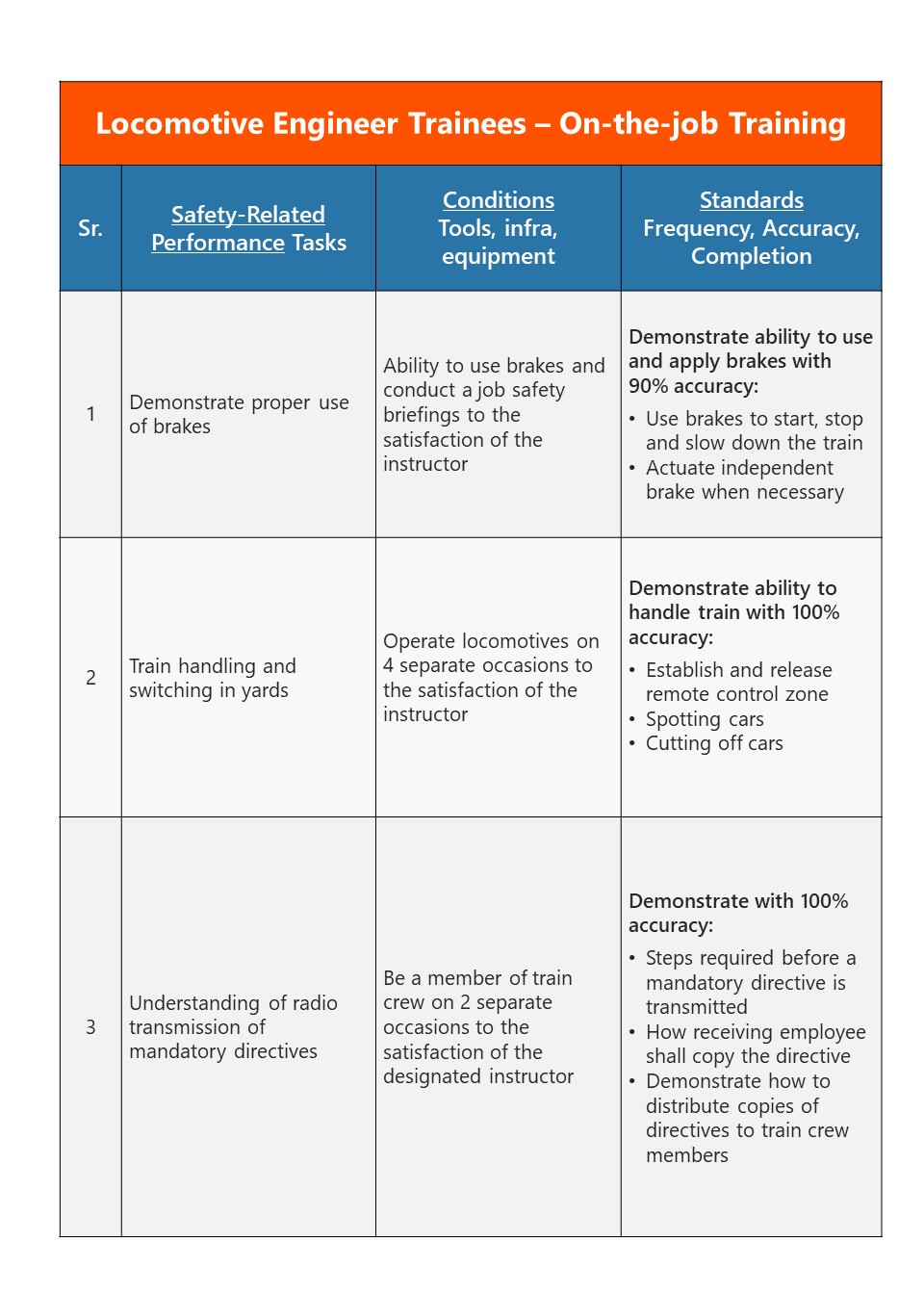Part 1
Effective on-the-job training management strategies for railroads as they manage 49 CFR Part 243 compliance
Building your OJT program
As a statutory requirement of the Rail Safety Act of 2008, the Federal Railroad Administration (FRA) has established minimum training standards requirements (or 49 CFR Part 243 compliance) for all safety-related employees working with railroad carriers, contractors, and Maintenance of Way (MoW) companies.
Today, we face a new chapter in 49 CFR Part 243 compliance. The deadline for railroads with less than 400,000 employee work hours annually to submit their training programs to the FRA is fast approaching in the early part of 2021. With this in mind, the timing is ripe to plan the execution and implementation of training and qualification management requirements as a part of this mandate.
In this 2-part blog series, we will highlight all the essentials of good on-the-job training management (OJT) program, followed by effective on-the-job training management strategies that are required to fulfill the FRA mandate requirements.
The 49 CFR Part 243 Mandate in a Nutshell
At a high level, here is what you need to know about the mandate:
- All safety-related employees must be trained and qualified to meet minimum FRA training standards
- Railroads, contractors, and MoW companies must submit training programs (Including OJT) for individual crafts to the FRA
- Employees must be trained with measurable standards (Including OJT) in accordance to the submitted training programs
- Railroad carriers, contractors, and MoW companies must maintain training records and submit them to FRA on-demand or during periodic audits.
- The training program submission deadline is set for May 1, 2021 for all contractors, and those Class II and III railroads that are not intercity or commuter passenger railroads with 400,000 total employee work hours annually or less.)
The prerequisites of a compliant, on-the-job training management program
With the premise that the FRA needs to have a good understanding of an OJT program (including the roles, responsibilities, administration, and implementation of on-the-job training), here are a few prerequisites to get you started:
- Classify safety-related railroad employees: All employees dispensing duties on the tracks, in the yard, and on the train, are directly responsible to ensure the safety of operations can be classified as safety-related railroad employees. These employees also include the supervisors, maintenance and installation specialists, and crew members.
- Roles and responsibilities: The roles for each safety-related craft or specialization can be defined as a part of your OJT program. For short line railroads, these roles can be unique from the roles used in Class I railroads given that employees may be responsible for the tasks grouped under more than one role.
Here are some examples of defined roles:
- The designated instructor or administrator: Allocates mentors to trainees, manages and defines OJT programs, provides program information to trainees and mentors, and manages the timelines and compliances
- Qualified mentor: Guides the trainees, conducts inspections and certifies the trainees
- Trainee: Follows the guidelines and shows proficiency in the assigned tasks
- Training program templates for each safety-related employee craft: Developing training program templates for individual safety-related crafts is probably the most important part of the 49 CFR Part 243 mandate. An ideal training template should outline the following:
- Performance tasks: A list and basic description of the tasks for each individual craft, which an employee must complete to be deemed proficient.
- Equipment, tools and conditions: A detailed description of the tools, equipment, and infrastructure required to conduct the tasks.
Task frequency, accuracy, and completion criteria: A quantified criteria to measure the completeness of the task. The number of task repetitions and accuracy rates is a few examples of task completion criteria.
A sample training program template ready to be submitted to FRA for looks like this:

Note: This is a sample training program template for the use of explaining the concept. This is not a suggested template.
4. Training records for both FRA and internal audits: Railroads must record, store, and retrieve comprehensive records into OJT program executions as a part of compliance documentation.
The records should throw light into training program details including (but not limited to):
- Training records of each individual employee
- Training records for each specific, safety-related craft
- Records into dates, timelines, and personnel associated with a particular OJT program
- Customized records as per FRA and internal requirements.
That’s it for part 1 in our 2-part blog post series on effective on-the-job training management as you prepare to meet the upcoming FRA deadline! In the next part of this blog post series, we’ll see how railroads can layout a technology-driven, strategic plan to meet 49 CFR Part 243 compliance.
On-demand webinar
Opportunities for digitalization in railroad contract management
Learn more about getting your OJT program ready in our webinar with the ASLRRA.
